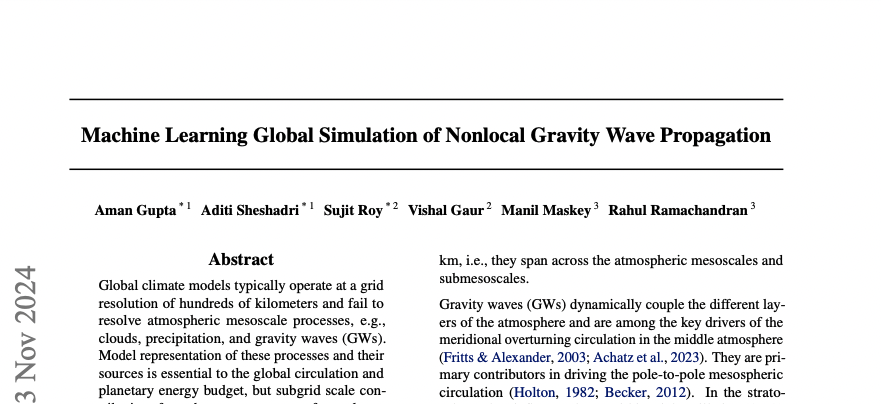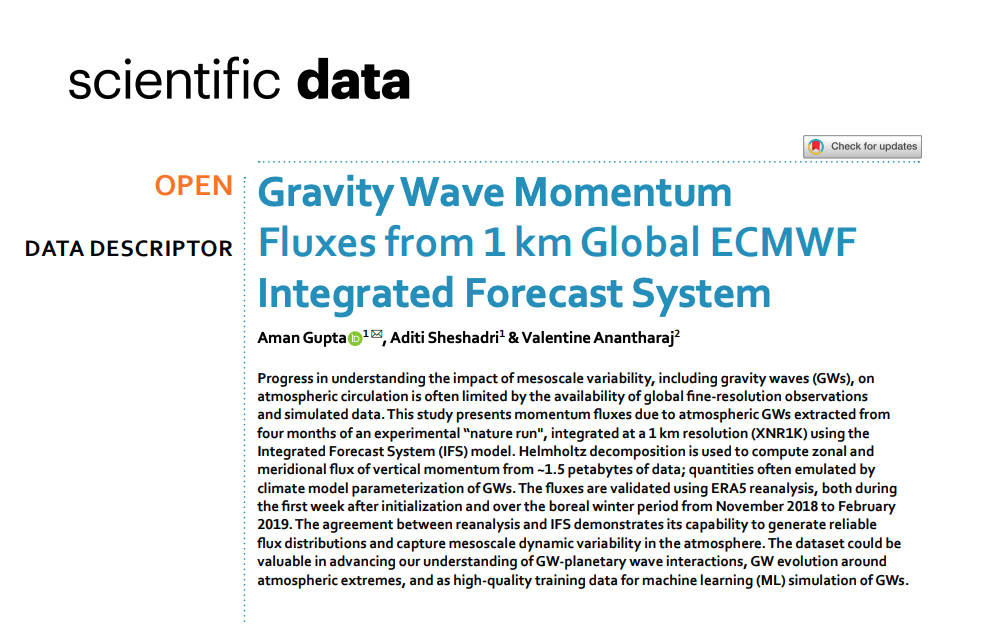Table of Contents
Task Groups
Task 1: Loon Observations and Gravity Wave Momentum Flux Estimates
Our first objective is to open up the Loon observation dataset to the research community, and use it to provide estimated of GW statistics in the lower stratosphere. Variables to be made available include temperature, pressure, and horizontal winds. Processed data will include estimates of vertical velocity and the momentum flux. Signals identified between the buoyancy and Coriolis periods can unambiguously be identified as GWs, which permits application of the GW dispersion and polarization relations (Fritts and Alexander(2003) and Gossard and Hooke(1975)).
GW momentum fluxes will be determined as a function of wave intrinsic frequency using wavelet analysis tools (Vincent and Hertzog, 2014).
Task 2: High-resolution Model Simulations of Gravity Waves
While Loon observations can provide comprehensive estimates of GW momentum fluxes in the lower stratosphere, they cannot provide a complete view of GW momentum deposition.To infer the drag, we will couple these observations with carefully validated model integrations (Alexander and Sato, 2015). We propose gravity-wave resolving simulations with the Weather and Research Forecast model (WRF) that are suitable for direct validation with Loon observations.
Orographic gravity waves:
GWs generated by flow over orography (OGW) are the most straightforward type of GW for a hybrid model-observation approach. Despite greater confidence in the source of OGWs, there remains a great deal of uncertainty in OGW drag; local weather conditions alter the vertical and horizontal propagation and breaking levels. We will validate high-resolution simulations initialized with matched weather conditions taken from weather and climate analyses with Loon observations (Alexander et al., 2019).
Non-orographic gravity waves:
GWs generated by convection (CGW) present a more challenging problem because the sources themselves are much more difficult to model: Even very high-resolution weather forecasting models with state-of-the-art initialization will more often than not fail to predict the correct timing and locations of individual intense rain cells that act as the strongest sources of CGW. Thus, we will employ a specialized data-driven approach developed by Stephan and Alexander (2015) in order to compare simulations of CGW with Loon observations. We will also examine the approach described in (de la Camara and Lott, 2015), using potential vorticity as the identifying source parameter for GW generation near fronts. This method has potential to include both dry dynamics and moisture effects on CGW through heating effects on potential vorticity generation.
Task 3: Ray Tracing-based Parameterization of Gravity Waves
We will develop ray-tracing GWP strategies, both as a potential alternative to current GWP, and as a source of data for ML schemes. This work will build on the generalized GW model MS-GWaM (Multi-Scale GW Model) and its implementation into the German NWP and climate community code ICON (Borchert et al., 2019), as described by Boloni et al (in prep.) and Kim et al (in prep.) by the research group in Frankfurt.
ICON/MS-GWaM as a data source and reference for ML parameterizations:
ICON/MS-GWaM will be integrated at varying resolution, 80, 40, and 20 km (for a limited integration), to enable validation against Loon data, and to provide global data.
Integration of OGWs into MS-GWaM:
OGW emission by time-varying flows is highly transient. Hence it is important to also replace the steady-state and 1D scheme from Lott and Miller (1997) for OGW drag by a corresponding source in MS-GWaM. This will first be tested it in our idealized local-area flow solver. Corresponding lessons will then be used in an implementation into ICON/MS-GWaM.
Efficiency improvement of MS-GWaM:
Following de la Camara and Lott (2015), we could coarse-grain MS-GWaM by randomly picking a subset of ray volumes. This stochastic approach will be enhanced by each ray volume representing an ensemble of smaller ray volumes. Experience from work on semi-empirical subgrid-scale parameterizations (Pierothet al., 2018;Zacharuk et al., 2018) will be used to represent the effect of the ensemble spread on the effective development of the representative ray volume, in close interaction with the ML experts in the project. The ensemble parameterization will be trained on output from the unsimplified MS-GWaM, and calibrated against available climatologies and Loon data.
Task 4: Machine Learning-based Parameterization of Gravity Waves
We propose applying a hierarchy of ML methods to emulate/estimate GWP schemes: random forests, deep artificial neural networks (ANNs), and convolutional neural networks. In assessing the performance of each ML method, our eventual metric is not only the offline accuracy of a trained data-driven scheme, but also the accuracy and stability when the data-driven scheme is implemented in a GCM and is used online in Task 5.
Emulating single-column parameterizations:
The first step is to emulate existing single-column (1D) GWPs with a data-driven approach. This will provide a faster parameterization with the same accuracy to accelerate climate model integrations. Our goal is to use this as a stepping stone toward new schemes constrained by observations and high-resolution model integrations of real GWs.
Developing a data-driven, single-column parameterization:
As Loon-based estimates of GW momentum fluxes become available through Tasks 1 and 2 we will use samples to develop 1-D data-driven parameterization to reproduce the GW momentum flux in the lower stratosphere. We start with 1D data-driven scheme for two reasons: First, development of a 1D ML-based data-driven scheme constrained data can guide and facilitate the development of a 3D scheme. Second, in the current weather and climate models, all physics-based parameterization schemes, including those for GWs, are single column to allow efficient parallelization.
Exploring efficient 3D data-driven parameterizations:
We will develop a 3-D data-driven representation using samples from the outputs of Tasks 2 and 3. Potential challenges in achieving this goal are that the 3-D representation is likely a complex function (at least compared with 1-D), while each 6-hourly 3D field providing a more limited number of samples, depending on the allowed spatial range of interactions. While explicitly requiring inter-column communication by a GWP would break the parallelization of climate physics packages, models can pass advected variables. We can therefore create new variable(s) to capture information on GW spectral properties (i.e., the mean and spectral width) that are advected and diffused by the resolved flow.
Task 5: Gravity Wave Impacts in Climate Projections
The final task is to implement the 1D and 3D data-driven GWPs in GCMs. Our objectives here are twofold: i) to assess the accuracy/stability of the data-driven GWPs when coupled to a GCM, and ii) to study phenomena such as the tropospheric jet, QBO, and polar vortex using the new ML-enabled GCMs. One challenge in this area is efficiently implementing3D GWPs in GCMs, whose numerical architectures are designed for 1D schemes.
Single-column model tests:
The 1D GWPs will first be tested in a single-column atmospheric model, where advective tendencies are provided as an external forcing to the column. Combining the PIs’ expertise in modeling and ML, we will develop strategies for accurate and stable integration of ML-based GWP schemes.
Full 3D model tests and the calibration problem:
The unresolved GW momentum flux depends critically on model resolution and numerical accuracy; one must carefully match a GWP to the fraction of the spectrum resolved by the model itself. As existing GWP are often “tuned” to generate a realistic QBO, this would be a good first point of contact with existing GWP development.
A second focus will be on the role of GWP on the climatology and variability of the polar stratospheric vortex. GCMs often suffer from a well known “cold pole bias”, where the polar stratosphere is too cold. When coupled with ozone chemistry, this accelerates stratospheric ozone loss; without tuning, models can produce an ozone hole in the NorthernHemisphere. The role of GWP in extreme variability of the stratospheric vortex will also be explored.
Finally, we will consider the response of the tropospheric jets, vortex, and QB Oto idealized climate change scenario experiments, particularly the instantaneous 4xCO2 integrations in the CMIP6 DECK profiles. The DynVarMIP (Gerber and Manzini, 2016) provides diagnostics of GW momentum deposition, allowing for an explicit comparison with CMIP6 models.
Publications
Recent Publications, Papers, and News
Machine Learning Global Simulation of Nonlocal Gravity Wave Propagation
Authors:
Aman Gupta, Aditi Sheshadri, Sujit Roy, Vishal Gaur, Manil Maskey, and Rahul Ramachandran
Abstract:
Global climate models typically operate at a grid resolution of hundreds of kilometers and fail to resolve atmospheric mesoscale processes, e.g., clouds, precipitation, and gravity waves (GWs). Model representation of these processes and their sources is essential to the global circulation and planetary energy budget, but subgrid scale contributions from these processes are often only approximately represented in models using parameterizations. These parameterizations are subject to approximations and idealizations, which limit their capability and accuracy.
Regression Forest Approaches to Gravity Wave Parameterization for Climate Projection
Authors:
David S. Connelly and Edwin P. Gerber
Abstract:
We train random and boosted forests, two machine learning architectures based on regression trees, to emulate a physics-based parameterization of atmospheric gravity wave momentum transport. We compare the forests to a neural network benchmark, evaluating both offline errors and online performance when coupled to an atmospheric model under the present day climate and in 800 and 1,200 ppm CO2 global warming scenarios. Offline, the boosted forest exhibits similar skill to the neural network, while the random forest scores significantly lower. Both forest models couple stably to the atmospheric model, and control climate integrations with the boosted forest exhibit lower biases than those with the neural network.
Gravity Wave Momentum Fluxes from 1 km Global ECMWF Integrated Forecast System
Authors:
Aman Gupta, Aditi Sheshadri, and Valentine Anantharaj
Abstract:
Progress in understanding the impact of mesoscale variability, including gravity waves (GWs), on atmospheric circulation is often limited by the availability of global fine-resolution observations and simulated data. This study presents momentum fluxes due to atmospheric GWs extracted from four months of an experimental “nature run", integrated at a 1 km resolution (XNR1K) using the Integrated Forecast System (IFS) model. Helmholtz decomposition is used to compute zonal and meridional flux of vertical momentum from ~1.5 petabytes of data; quantities often emulated by climate model parameterization of GWs.


